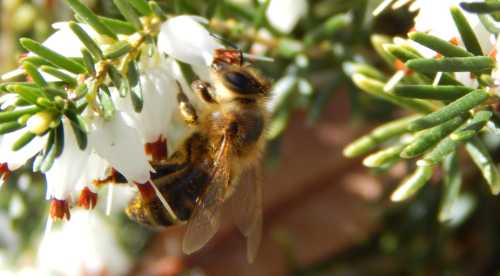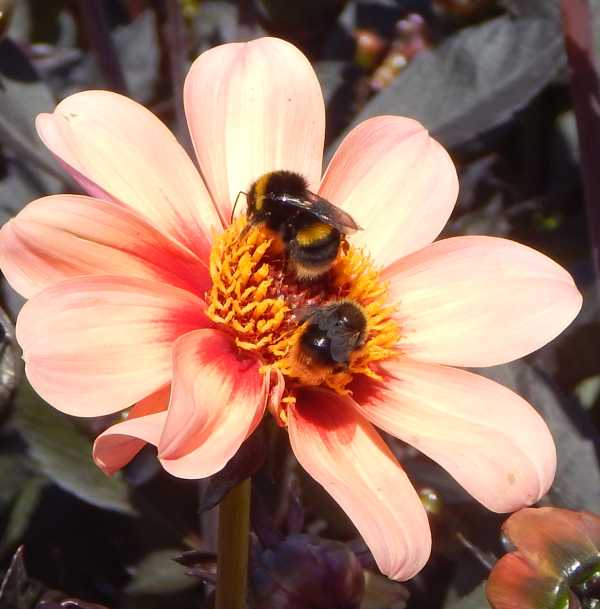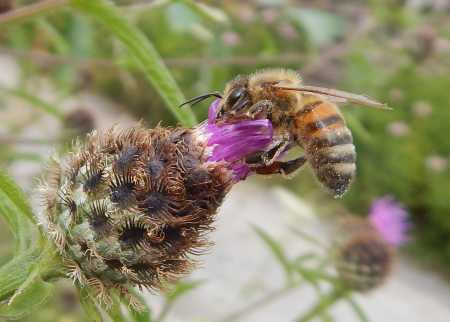Do Honey Bees Poop?
The short
answer is:
Yes, honey bees
poop, and the activity of bees pooping has been observed by scientists,
beekeepers and nature watchers for a variety of bee species.
As with humans and other creatures, the act of defecating (releasing poop from the body) is important for bees, because it's a valuable bodily function for expelling undigested food wastage from the body.
Where do honey bees poop?
Adult worker honey bees are hygienic, and poop outside the hive . Even in winter when worker bees cannot leave the nest or hive to forage, worker honey bees hold on to their poop, and take what is known as ‘cleansing flights’ when they can. These are short flights (winter weather permitting) when they leave the hive in order to poop.
Does the queen honey bee also poop?
Yes, the queen also poops, although her poop is cleaned out of the hive by the workers.

What does honey bee poop look like?
Healthy honey
bee poop is yellow in color, and is somewhat sticky. It might appear as
yellow droplets, a sausage shape or 'splat'.
Beekeepers who recognize bee poop may see it on their windowsill, garden furniture or car. People who live close to a regular honey bee flight path may also see bee poop (although they may not know what it is).
In cooler weather, honey bee workers may poop on the beehive itself, since they are less likely to fly far from the hive.
What is honey bee poop made of?
Honey bee
poop has been found to primarily contain bits of undigested pollen fat, pollen
grains from flowers visited, and other waste.
Is it harmful?
I'm not aware of it being harmful in any way to humans or other animals.
Is
honey actually bee poop?
No. Honey is mostly made from nectar collected by honey bees during foraging trips on flowers.
The honey bee takes the nectar back to the hive in its crop, where it is passed from bee to bee, whilst adding the bee’s own ingredient (the bee enzyme) before it is deposited into a cell made of wax where it will be turned into honey.
Read more about this
process: how bees make honey.
Do honey bees get diarrhea?
Yes. Honey bee dysentery is a type of diarrhea that honey bees may get1, for example, if they have too much poop in their bodies, and are struggling to get out of the hive in the winter to take cleansing flights so they can get rid of it.
4 Interesting facts about bees and poop!
- Honey bees sometimes use animal poop to defend their nests!
Scientists have discovered that the Asiatic honey bee, Apis cerana, may use the poop of animals to defend their nests against giant hornets2!
In Asia, giant hornets attack honey bee colonies in groups. They kill adult defenders (guard bees), and prey on brood. By collecting the poop of animals and 'spotting' it around the nest entrances, honey bees are able to deter the hornets from approaching the nest! - Bee poop tells scientists which flowers were visited by bees
Scientists are able to collect bee poop and analyze the pollen grains it contains. By doing this, they can find out what the bee has been foraging on. (The study of pollen in honey is called 'melissopalynology').
Studying pollen grains in honey can also help scientists to answer other questions, such as how far bees fly to forage for food. - Bees sometimes eat poop and drink urine!
Honey bees have been observed to drink urine, and although not commonly reported, bumble bees have been seen not only to drink urine, but also to feed on meat and bird droppings! - Bee poop as a health indicator
Infectious diseases such as Chronic Bee Paralysis Virus can be spread and identified via bee poop3. Bee poop can also be collected and used to find out about the health of a honey bee colony. Beekeepers may collect samples of the poop and send it off to a specialist laboratory. The scientists will examine the poop to see if it contains any evidence of disease or infection.
Resources
1. L. Bailey (1967) Nosema Apis and Dysentery of the Honeybee, Journal of Apicultural Research, 6:3, 121-125, DOI: 10.1080/00218839.1967.11100171
2. Mattila HR, Otis GW, Nguyen LTP, Pham HD, Knight OM, Phan NT (2020) Honey bees (Apis cerana) use animal feces as a tool to defend colonies against group attack by giant hornets (Vespa soror). PLoS ONE 15(12): e0242668. https://doi.org/10.1371/journal.pone.0242668.
3. Ribière M, Lallemand P, Iscache AL, Schurr F, Celle O, Blanchard P, Olivier V, Faucon JP. Spread of infectious chronic bee paralysis virus by honeybee (Apis mellifera L.) feces. Appl Environ Microbiol. 2007 Dec;73(23):7711-6. doi: 10.1128/AEM.01053-07. Epub 2007 Oct 12. PMID: 17933946; PMCID: PMC2168079.
If you found this page helpful or interesting, I'd really be grateful if you would share it with others - if not this page, perhaps another, such as Gardening For Bees.
Thank you so much :) .

